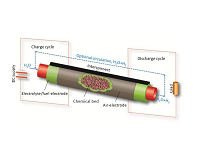Bi-functional Ceramic Fuel Cell Energy System

Technology Description:
The University of South Carolina is developing an intermediate-temperature, ceramic-based fuel cell that will both generate and store electrical power with high efficiencies. Reducing operating temperatures for fuel cells is critical to enabling distributed power generation. The device will incorporate a newly discovered ceramic electrolyte and nanostructured electrodes that enable it to operate at temperatures lower than 500ºC, far below the temperatures associated with fuel cells for grid-scale power generation. The fuel cell’s unique design includes an iron-based layer that stores electrical charge like a battery, enabling a faster response to changes in power demand.
Potential Impact:
If successful, the University of South Carolina’s intermediate-temperature fuel cell will triple the power density and energy capacity of existing fuel cells at less than 500ºC, enabling distributed power generation.
Security:
Enabling more efficient use of natural gas for power generation provides a reliable alternative to other fuel sources—a broader fuel portfolio means more energy security.
Environment:
Natural gas produces roughly half the carbon dioxide emissions of coal, making it an environmentally friendly alternative to existing sources of power generation.
Economy:
Distributed generation technologies would reduce costs associated with power losses compared to centralized power stations and provide lower operating costs due to peak shaving.
Contact
ARPA-E Program Director:
Dr. Paul Albertus
Project Contact:
Prof. Kevin Huang
Press and General Inquiries Email:
ARPA-E-Comms@hq.doe.gov
Project Contact Email:
huang46@cec.sc.edu
Partners
Acumentrics Corporation
University of Texas, Austin
Related Projects
Release Date:
11/25/2013
